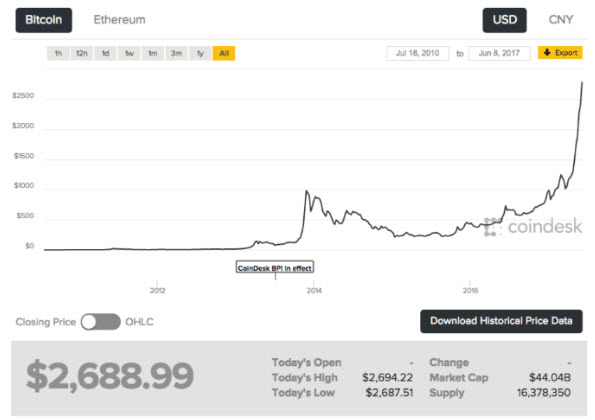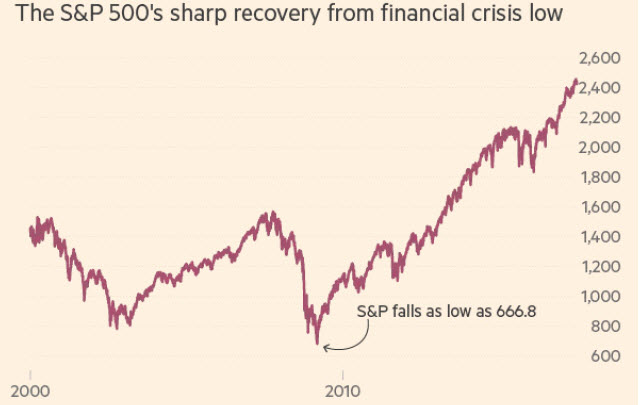A Good Time to Sell?
 Saturday, August 12, 2017 at 5:10PM
Saturday, August 12, 2017 at 5:10PM I got a call this week from a client who wanted to sell more than 50% of their investments over fear that the North Korea situation might balloon into something big. Despite my assurances that the market is trading within 1% of an all-time high, and if institutions with billions of dollars under management weren't selling, why would we? What do we know that they, with their millions of dollars in market and geo-political risk assessment research, don't know? And once you sell, how will you know when to get back in?
So far, the world markets seem to be shrugging off the sabre-rattling coming from North Korea (normal behavior) and the U.S. White House (complete departure from policy). The smart money is betting that the distant but suddenly headline-grabbing possibility of the first conflict between two countries armed with nuclear weapons will amount to a tempest in a teapot.
Meanwhile, the U.S. stock market has been testing new highs for months, and experts cannot quite explain why valuations have been rising amid such low volatility.
So the question is quite logical: isn’t this a good time to pare back or get out of the market until valuations return to their historical norms, or at least until the North Korean “crisis” blows over?
The quick answer is that there’s never a good time to try to time the market, especially as concerns geo-political events. The longer answer is that this may actually be a particularly bad time to try it.
What’s happening between the U.S. and North Korea is admittedly unprecedented. In the past, the U.S. largely ignored the bluster and empty threats coming out of the tiny, dirt-poor communist regime, and believe it or not, that also seems to be what the military is doing now. Yes, our President did blurt out the term “fire and fury” in impromptu remarks to the press, and later doubled down on the term by suggesting that his warning wasn’t worded strongly enough. But the U.S. military seems to be responding with a yawn. There are no Naval carrier groups anywhere near Korea at the moment; the U.S.S. Carl Vinson and the U.S.S. Theodore Roosevelt are both still engaged in training exercises off the U.S. West Coast, and the U.S.S. Nimitz is currently patrolling the Persian Gulf. Nor has the State Department called for the evacuation of non-essential personnel from South Korea, as it would if it believed that tensions were leading toward a military confrontation.
Meanwhile, on the home front, the U.S. economy continues to grow slowly but steadily, and in the second quarter of 2017, 72.2% of companies in the S&P 500 index have reported earnings above forecast.
What does this all mean? It means that you will probably see a certain amount of selling due to panic over the North Korean standoff, which will make stocks less expensive—a classic buying opportunity. August and September have been somewhat volatile months in the past, so the North Korean standoff gives some "cover" for selling. Nonetheless, history has given all of us many opportunities to panic, going back to World War I and World War II, and more recently 9/11—but those who stayed the course reaped enormous benefits from those who abandoned their stock positions. It should be understood that it's not the known perils that usually cause a major market selloff; it's the ones that we don't see coming.
If you’re feeling panic over the North Korean situation, by all means, go in the nearest bedroom and scream—and then share some sympathy for the Americans living in the island territory of Guam, which is in the direct path of the North Korean bluster. Sure, if you have held your investments throughout this bull market and haven't taken any profits, it doesn't hurt to trim a few positions or to hedge them. Just don’t sabotage your financial plan and well-being in the process by selling a large chunk of your investments in response to what may amount to a non-event.
If you're having trouble sleeping at night worrying over your portfolio, then you are probably holding more risk than you should (you know your risk score, right?) So there's nothing wrong with reducing the risk of your portfolio if it makes you uncomfortable. Work with your advisor to reduce the risk of your portfolio to the "sleeping soundly" point. Just don't wait for geopolitical events to force you to sell in a panic.
A recent true story I read, helps keep these sort of things in perspective:
During the 1962 Cuban missile crisis, warships were parked off the coast of Cuba, and the Soviet Union and the U.S have nuclear weapons pointed at each other in the highest possible state of alert. The market is falling and Mike Epstein is at the center of the action as a trader on the floor of the New York Stock Exchange. Mike turns to his boss and asks what he should do. His boss tells him “hit the ask and buy ‘em.” Mike politely questions the sanity of his boss because he realizes the world may be coming to end in a nuclear holocaust. His boss tells him to keep buying, “if they don’t nuke us the market will bounce, and if they do you won’t have to worry about paying for them!”
If you would like to review your current investment portfolio or discuss any other financial planning matters, please don’t hesitate to contact us or visit our website at http://www.ydfs.com. We are a fee-only fiduciary financial planning firm that always puts your interests first. If you are not a client yet, an initial consultation is complimentary and there is never any pressure or hidden sales pitch. We start with a specific assessment of your personal situation. There is no rush and no cookie-cutter approach. Each client is different, and so is your financial plan and investment objectives.
The MoneyGeek thanks guest writer Bob Veres for his contribution to this post.


